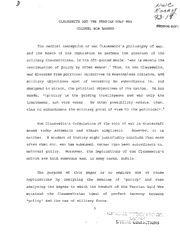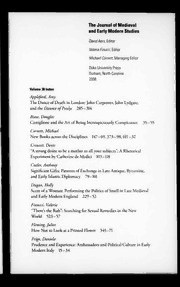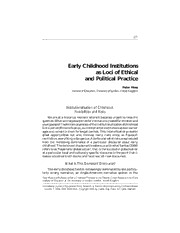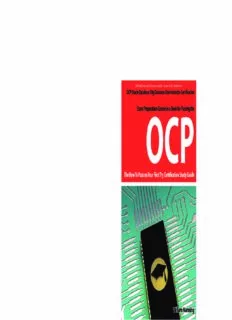
Oracle Database 10g Database Administrator OCP Certification Exam Preparation Course in a Book for Passing the Oracle Database 10g Database ... on Your First Try Certification Study Guide PDF
Preview Oracle Database 10g Database Administrator OCP Certification Exam Preparation Course in a Book for Passing the Oracle Database 10g Database ... on Your First Try Certification Study Guide
O This self-study exam preparation guide for the Oracle Database 10g Database racle Administrator OCP certification exam contains everything you need to test yourself and D a pass the Exam. All Exam topics are covered and insider secrets, complete explanations of tab a all Oracle Database 10g Database Administrator OCP subjects, test tricks and tips, se numerous highly realistic sample questions, and exercises designed to strengthen 10 g understanding of Oracle Database 10g Database Administrator OCP concepts and D a prepare you for exam success on the first attempt are provided. tab a se Gain Advanced Oracle Skills with OCP 10g Certification. Gain respect and industry Ad m recognition of your skills in managing Oracle 10g, one of the most powerful relational in databases in the world, with the Oracle Certified Professional 10g certification. istra to r O Oracle certifications are industry-recognised, sought-after credentials that can help you CP succeed in your IT career. Ce The OCP 10g demonstrates your expertise with Oracle Database 10g, the industry's first rtificatio n relational database designed for grid computing. E xa m This advanced certification proves your skills in configuring an Oracle database for Pre multilingual applications, using various methods of recovering and tuning the database, pa ra and using database technologies such as Resource Manager, Scheduler and Automatic tio n Storage Management (ASM). C o u Can you imagine valuing a book so much that you send the author a "Thank You" letter? rse in a B Tens of thousands of people understand why this is a worldwide best-seller. Is it the oo authors years of experience? The endless hours of ongoing research? The interviews k fo with those who failed the exam, to identify gaps in their knowledge? Or is it the razor- r Pa sharp focus on making sure you don't waste a single minute of your time studying any ssin g more than you absolutely have to? Actually, it's all of the above. th e O This book includes new exercises and sample questions never before in print. Offering racle numerous sample questions, critical time-saving tips plus information available D a nowhere else, this book will help you pass the Oracle Database 10g Database tab a Administrator OCP exam on your FIRST try. se 1 0 g Up to speed with the theory? Buy this. Read it. And Pass the Oracle Database 10g Da Database Administrator OCP Exam. tab a se A d m in istra to r O C P E xa m - T h e H o w T o P a ss o n Y o u r F irst T ry C e rtifica ISBN 978-1-74244-231-0 tion 90000 S tu d y G u id e 9 781742 442310 Foreword This Exam Preparation book is intended for those preparing for the Oracle Database 10g Database Administrator OCP certification. This book is not a replacement for completing a course. This is a study aid to assist those who have completed an accredited course and preparing for the exam. Do not underestimate the value of your own notes and study aids. The more you have, the more prepared you will be. Due to licensing rights, we are unable to provide actual Oracle Database 10g Database Administrator OCP Exam. However, the study notes and sample exam questions in this book will allow you to more easily prepare for an Oracle Database 10g Database Administrator OCP exam. Good luck! Ivanka Menken Executive Director The Art of Service Table of Contents FOREWORD ................................................................................................ 1 TABLE OF CONTENTS ................................................................................... 2 1 ORACLE DATABASE 10G ADMINISTRATION II CERTIFICATION ............. 9 2 EXAM SPECIFICS ............................................................................... 10 3 ORACLE DATABASE 10G ARCHITECTURE ........................................... 11 3.1 ORACLE 10G ......................................................................................... 11 3.2 DATABASE CONCEPTS .............................................................................. 12 3.2.1 Structured Query Language .................................................... 12 3.2.2 Database Constructs ............................................................... 13 3.2.3 Metadata Views ...................................................................... 13 3.2.4 Relationships and Constraints ................................................ 14 3.2.5 Segment Types ........................................................................ 15 3.2.6 Communicating Between Segments ....................................... 16 3.3 ORACLE ARCHITECTURE ........................................................................... 17 3.3.1 Database Administrator.......................................................... 17 3.3.2 Database Server Architecture ................................................. 17 3.3.3 System Global Area ................................................................. 18 3.3.4 Basic Initialization Parameters ............................................... 19 3.3.5 Oracle Background Processes ................................................. 21 3.3.6 Oracle Database ...................................................................... 22 3.4 INSTALLING ORACLE 10G ......................................................................... 24 3.4.1 Review Documentation ........................................................... 24 3.4.2 System Requirements .............................................................. 25 3.4.3 Installation Plan ...................................................................... 25 3.4.4 Oracle Universal Installer ........................................................ 26 4 DATABASE CREATION ...................................................................... 28 4.1 ORACLE DATABASE ................................................................................. 28 4.1.1 Management Framework ....................................................... 28 4.1.2 Oracle Management Agents ................................................... 29 4.1.3 Oracle Database Configuration Assistant (ODCA) ................. 30 4.1.4 Database Templates ............................................................... 30 4.1.5 Database Credentials .............................................................. 31 4.1.6 Storage Options ....................................................................... 31 4.1.7 Recovery Configuration ........................................................... 33 4.1.8 Database Content ................................................................... 34 4.1.9 Initialization Parameters ........................................................ 34 4.1.10 Database Storage ............................................................... 36 4.1.11 Creation Options ................................................................. 36 2 Copyright The Art of Service │Brisbane, Australia│Email:service@theartofservice.com Web: http://theartofservice.com │eLearning: http://theartofservice.org │Phone: +61 (0)7 3252 2055 4.2 OTHER DBCA ACTIVITIES ......................................................................... 37 4.2.1 Configuring the Database ....................................................... 37 4.2.2 Deleting the Database ............................................................ 37 4.2.3 Managing Templates .............................................................. 37 4.3 PARAMETER INITIALIZATION FILES .............................................................. 38 4.4 START AND STOP DATABASES ................................................................... 39 4.4.1 Administrative Authorization ................................................. 39 4.4.2 Startup Modes ......................................................................... 40 4.4.3 Special Startup Modes ............................................................ 41 4.4.4 EM Database Control Startup ................................................. 41 4.4.5 SQL*Plus Startup ..................................................................... 42 4.4.6 Database Shutdown Processes ............................................... 42 4.4.7 EM Database Control Shutdown ............................................. 43 4.4.8 SQL*Plus Shutdown ................................................................. 44 4.4.9 Alert Log Monitoring ............................................................... 44 5 DATABASE STORAGE ........................................................................ 45 5.1 STORAGE STRUCTURES ............................................................................ 45 5.1.1 Tablespace Management ....................................................... 45 5.1.2 Creating Tablespaces .............................................................. 46 5.1.3 Other Tablespaces ................................................................... 48 5.1.4 Removing and Modifying Tablespace .................................... 49 5.1.5 Tablespace Information .......................................................... 50 5.2 DATAFILE MANAGEMENT ......................................................................... 51 5.3 SCHEMA OBJECTS ................................................................................... 52 5.3.1 Datatypes ................................................................................ 53 5.3.2 Tables ....................................................................................... 56 5.3.3 Creating Tables ........................................................................ 57 5.3.4 Table Management ................................................................. 58 5.3.5 Constraints............................................................................... 59 5.3.6 Indexes ..................................................................................... 61 5.3.7 Managing Indexes ................................................................... 61 5.3.8 Views ....................................................................................... 62 5.3.9 Sequences ................................................................................ 63 6 RECOVERY MANAGER ...................................................................... 64 6.1 RECOVERY MANAGER FEATURES ............................................................... 64 6.1.1 RMAN Components ................................................................. 65 6.1.2 RMAN Usage ........................................................................... 66 6.1.3 Repository and Control Files ................................................... 67 6.1.4 Recovery Catalog ..................................................................... 67 6.2 STARTING AND CONNECTING TO RMAN ..................................................... 69 6.2.1 Connecting to Target Database .............................................. 69 3 Copyright The Art of Service │Brisbane, Australia│Email:service@theartofservice.com Web: http://theartofservice.com │eLearning: http://theartofservice.org │Phone: +61 (0)7 3252 2055 6.2.2 Connecting to Recovery Catalog ............................................. 70 6.3 CONFIGURING RMAN ............................................................................ 70 6.3.1 Media Management Layer ..................................................... 70 6.3.2 Channel Allocation .................................................................. 70 6.3.3 RMAN Parameters and Persistent Settings ............................ 72 6.3.4 EM Configuration of RMAN Settings ...................................... 72 6.3.5 Retention Policies .................................................................... 73 6.3.6 Control File Autobackup .......................................................... 73 6.4 USING RECOVERY MANAGER .................................................................... 74 6.4.1 RMAN Commands .................................................................... 74 6.4.2 Backup Sets and Image Copies ............................................... 77 6.4.3 Compressed Backups ............................................................... 78 6.4.4 Full and Incremental Backups ................................................. 78 6.4.5 Parallelization ......................................................................... 79 6.4.6 Backup Options ....................................................................... 79 6.4.7 Block Change Tracking ............................................................ 80 6.4.8 Monitoring Backups ................................................................ 81 6.4.9 LIST Commands ....................................................................... 81 6.4.10 REPORT Commands ............................................................ 82 7 DATABASE RECOVERY ...................................................................... 83 7.1 RECOVERY PROCESS ................................................................................ 83 7.2 SERVER‐MANAGED RECOVERY .................................................................. 83 7.2.1 User‐Managed Recovery ......................................................... 84 7.2.2 Recovering Control Files .......................................................... 84 7.2.3 Performing Incomplete Recoveries ......................................... 85 7.2.4 Recovery Through Enterprise Manager .................................. 86 7.2.5 RESETLOGS Operation ............................................................. 86 7.3 USING THE FLASHBACK DATABASE ............................................................. 87 7.3.1 Flashback Databases ............................................................... 87 7.3.2 Managing the Flash Recovery Area ........................................ 88 7.3.3 Configuring the Flash Memory Area ....................................... 89 7.3.4 Using the Flash Memory Area ................................................. 89 7.3.5 Backup the Flash Recovery Area ............................................. 91 7.3.6 Configuring the Flashback Database ...................................... 91 7.3.7 Using RMAN with the Flashback Database ............................ 91 7.3.8 Monitoring the Flashback Database ...................................... 92 7.3.9 Using EM with the Flashback Database ................................. 92 7.4 NON‐CRITICAL LOSSES ............................................................................. 93 7.4.1 Temporary Tablespaces .......................................................... 93 7.4.2 Redo Log Files .......................................................................... 94 7.4.3 Index Tablespaces ................................................................... 94 7.4.4 Indexes ..................................................................................... 95 4 Copyright The Art of Service │Brisbane, Australia│Email:service@theartofservice.com Web: http://theartofservice.com │eLearning: http://theartofservice.org │Phone: +61 (0)7 3252 2055 7.4.5 Read‐Only Tablespaces ........................................................... 95 7.4.6 Password File ........................................................................... 95 7.5 USER ERROR RECOVERY ........................................................................... 96 7.5.1 Overview of Technologies ....................................................... 96 7.5.2 Using Flashdrop Drop .............................................................. 96 7.5.3 Flashback Dropped Tables ...................................................... 98 7.5.4 Flashback Versions Query ....................................................... 98 7.5.5 Flashback Transaction Query ................................................... 99 7.5.6 Flashback Table ..................................................................... 100 7.6 BLOCK CORRUPTION ............................................................................. 100 7.6.1 Symptoms of Block Corruption ............................................. 100 7.6.2 Detecting and Resolve Corruption ........................................ 101 7.6.3 Block Media Recovery ........................................................... 103 8 AUTOMATED SERVICES .................................................................. 104 8.1 AUTOMATIC DATABASE MANAGEMENT .................................................... 104 8.1.1 Automatic Workload Repository (AWR) ............................... 105 8.1.2 Active Session History ........................................................... 108 8.1.3 Snapshots .............................................................................. 109 8.1.4 AWR Baselines ....................................................................... 110 8.1.5 AWR Views ............................................................................ 110 8.1.6 AWR Reports ......................................................................... 110 8.2 SERVER GENERATED ALERTS ................................................................... 111 8.2.1 Alert Process .......................................................................... 111 8.2.2 Configuring Thresholds ......................................................... 111 8.3 AUTOMATIC ROUTINE ADMINISTRATION TASKS .......................................... 113 8.3.1 Automatic Statistics Collection ............................................. 114 8.3.2 Dictionary Statistics ............................................................... 115 8.3.3 System Statistics .................................................................... 115 8.3.4 Operating System Statistics .................................................. 115 8.3.5 User Defined Statistics .......................................................... 116 8.3.6 Collecting Statistics ............................................................... 116 8.3.7 Volatile Objects ..................................................................... 117 8.3.8 DML Table Changes ............................................................... 117 8.3.9 STATISTICS_LEVEL Parameter ............................................... 118 8.4 ADVISORY FRAMEWORK ........................................................................ 119 8.4.1 Advisors ................................................................................. 119 8.4.2 Invoking Advisors .................................................................. 120 8.4.3 DBMS_ADVISOR Package ..................................................... 121 8.4.4 Advisor Views ........................................................................ 122 8.4.5 Automatic Database Diagnostic Monitor ............................. 122 8.4.6 SQL Tuning Advisor................................................................ 123 8.5 AUTOMATIC STORAGE MANAGEMENT ...................................................... 125 5 Copyright The Art of Service │Brisbane, Australia│Email:service@theartofservice.com Web: http://theartofservice.com │eLearning: http://theartofservice.org │Phone: +61 (0)7 3252 2055 8.5.1 ASM Architecture .................................................................. 125 8.5.2 ASM Instance ......................................................................... 126 8.5.3 Dynamic Performance Views ................................................ 127 8.5.4 File Types and Templates ...................................................... 128 8.5.5 ASM Disk Groups ................................................................... 129 8.5.6 Recovery with ASM ............................................................... 131 8.6 GLOBALIZATION SUPPORT ...................................................................... 132 8.6.1 Features for Globalization .................................................... 132 8.6.2 Architecture for Globalization Support ................................. 133 8.6.3 NLS Parameters ..................................................................... 134 8.6.4 NLS Views .............................................................................. 135 8.6.5 Linguistic Sorts and Searches ................................................ 136 8.6.6 Linguistic Parameters ............................................................ 138 8.6.7 Linguistic Sort Types .............................................................. 139 9 MANAGING RESOURCES ................................................................ 140 9.1 DATABASE RESOURCE MANAGER ............................................................ 140 9.1.1 Pending Area ......................................................................... 140 9.1.2 Resource Consumer Groups .................................................. 141 9.1.3 User Session Assignments ..................................................... 142 9.1.4 Resource Plans ....................................................................... 143 9.1.5 Resource Plan Directives ....................................................... 145 9.2 AUTOMATING TASKS ............................................................................. 147 9.2.1 Scheduler ................................................................................ 147 9.2.2 Scheduler Architecture .......................................................... 148 9.2.3 Administration Tools ............................................................. 149 9.2.4 Setting Attributes .................................................................. 150 9.2.5 Scheduler Jobs ....................................................................... 151 9.2.6 Job Classes ............................................................................. 151 9.2.7 Calendaring ........................................................................... 152 9.2.8 Scheduler Windows ............................................................... 153 9.2.9 Scheduler Views .................................................................... 154 10 PRACTICE EXAM ............................................................................. 155 10.1 QUESTIONS .................................................................................... 155 11 ANSWER GUIDE ............................................................................. 168 12 REFERENCES .................................................................................. 174 13 GLOSSARY ..................................................................................... 175 6 Copyright The Art of Service │Brisbane, Australia│Email:service@theartofservice.com Web: http://theartofservice.com │eLearning: http://theartofservice.org │Phone: +61 (0)7 3252 2055 Notice of Rights All rights reserved. No part of this book may be reproduced or transmitted in any form by any means, electronic, mechanical, photocopying, recording, or otherwise, without the prior written permission of the publisher. Notice of Liability The information in this book is distributed on an “As Is” basis without warranty. While every precaution has been taken in the preparation of the book, neither the author nor the publisher shall have any liability to any person or entity with respect to any loss or damage caused or alleged to be caused directly or indirectly by the instructions contained in this book or by the products described in it. Trademarks Many of the designations used by manufacturers and sellers to distinguish their products are claimed as trademarks. Where those designations appear in this book, and the publisher was aware of a trademark claim, the designations appear as requested by the owner of the trademark. All other product names and services identified throughout this book are used in editorial fashion only and for the benefit of such companies with no intention of infringement of the trademark. No such use, or the use of any trade name, is intended to convey endorsement or other affiliation with this book. 7 Copyright The Art of Service │Brisbane, Australia│Email:service@theartofservice.com Web: http://theartofservice.com │eLearning: http://theartofservice.org │Phone: +61 (0)7 3252 2055 Write a review to receive any free eBook from our Catalog - $99 Value! If you recently bought this book we would love to hear from you! Benefit from receiving a free eBook from our catalog at http://www.emereo.org/ if you write a review on Amazon (or the online store where you purchased this book) about your last purchase! How does it work? To post a review on Amazon, just log in to your account and click on the Create your own review button (under Customer Reviews) of the relevant product page. You can find examples of product reviews in Amazon. If you purchased from another online store, simply follow their procedures. What happens when I submit my review? Once you have submitted your review, send us an email at review@emereo.org with the link to your review, and the eBook you would like as our thank you from http://www.emereo.org/. Pick any book you like from the catalog, up to $99 RRP. You will receive an email with your eBook as download link. It is that simple! 8 Copyright The Art of Service │Brisbane, Australia│Email:service@theartofservice.com Web: http://theartofservice.com │eLearning: http://theartofservice.org │Phone: +61 (0)7 3252 2055 Oracle Database 10g Administration II Certification The certification for Oracle Database 10g Administration II is a step of the Oracle Certified Professional program. Candidates who have the certification have knowledge in the configuration of an Oracle database for multilingual applications. Additional topics covered by the certification include Oracle technologies and features such as: Resource Manager Scheduler Automatic Storage Management VLDB Flashback Globalization Oracle Certified Associate for Database Administration is a prerequisite for Oracle training and exams for the Oracle Certified Professional step. 9 Copyright The Art of Service │Brisbane, Australia│Email:service@theartofservice.com Web: http://theartofservice.com │eLearning: http://theartofservice.org │Phone: +61 (0)7 3252 2055
Description:The list of books you might like

The Strength In Our Scars

Shatter Me Complete Collection (Shatter Me; Destroy Me; Unravel Me; Fracture Me; Ignite Me)

The 5 Second Rule: Transform your Life, Work, and Confidence with Everyday Courage

As Good as Dead

Negro zine 2 (2006 Apr)
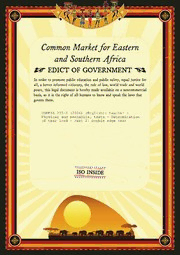
COMESA 235-2: Leather - Physical and mechanical tests - Determination of tear load - Part 2: Double edge tear
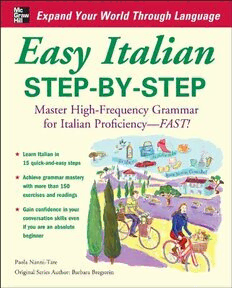
Easy Italian Step-by-Step
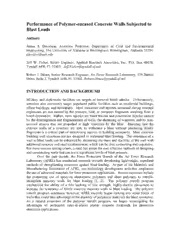
DTIC ADA442146: Performance of Polymer-Encased Concrete Walls Subjected to Blast Loads

La amarga pasión de Cristo
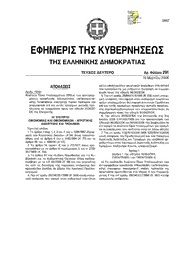
Greek Government Gazette: Part 2, 2006 no. 291

Kickin' It (Red Card)

The Brooklyn Paper Volume 29 Issue 48
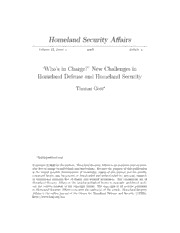
DTIC ADA483967: Who's in Charge? New Challenges in Homeland Defense and Homeland Security

Graduate Bulletin 2006-2007, LaGrange College, LaGrange, Georgia
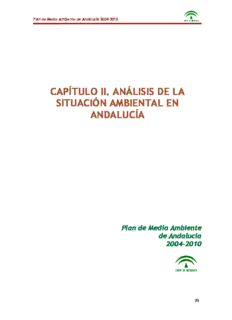
capítulo ii. análisis de la situación ambiental en andalucía
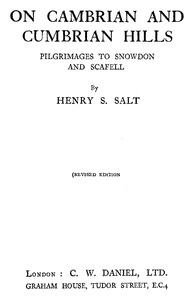
On Cambrian and Cumbrian Hills: Pilgrimages to Snowdon and Scafell by Henry S. Salt

c 2009 by Kyoungsoo Park
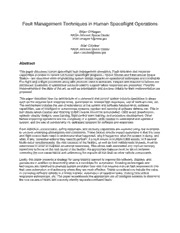
NASA Technical Reports Server (NTRS) 20080026132: Fault Management Techniques in Human Spaceflight Operations
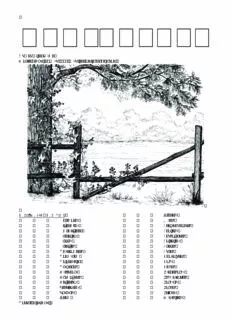
C11 byanyothername

CAUT Bulletin June 2006 (Volume 53, Number 6)
